Understanding
climate:
Antarctic sea ice extent
20 November, 2019
As it does in the Arctic, the surface of the ocean around Antarctica freezes over in the winter and melts back each summer. Antarctic sea ice usually reaches its annual maximum extent in mid- to late September, and reaches its annual minimum in late February or early March. The start of 2019 brought the lowest Antarctic sea ice extent on record for that time of year, but although the 2019 minimum extent (on February 28, 2019) was well below the 1981–2010 climatological average, it was not a record low.
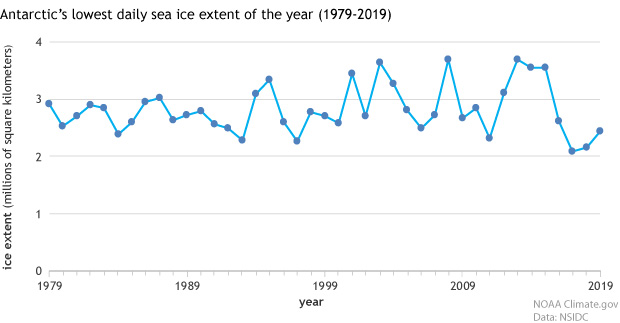
This graph shows each year’s minimum ice extent—the lowest daily extent of the year—since the start of the satellite record in 1979. Extent is the total area where the ice concentration is 15 percent or higher. In the past decade, the yearly minimum has been extremely variable, hitting both record highs and lows. NOAA Climate.gov graphic from National Snow and Ice Data Center data.
The timing of the seasonal cycles isn’t the only way that Antarctic sea ice differs from the Arctic. One key difference is the larger range between austral winter maximum extent and summer minimum extent. Antarctic sea ice extends to about 7 million square miles in winter, versus 6 million square miles in the Arctic; the Antarctic summer minimum is about 1 million square miles versus 2.5 million square miles for the Arctic.
The differences in seasonal extremes are due to basic geography. The Arctic is an ocean basin largely surrounded by land. Sea ice forms over the North Pole itself—the hemisphere’s highest, coldest latitudes—but its expansion is checked by Eurasia, North America, and Greenland. The Antarctic is a continent surrounded by a vast ocean. Sea ice can expand freely across the Southern Ocean in winter, but it can get no closer to the South Pole than the Antarctic coastline will allow.
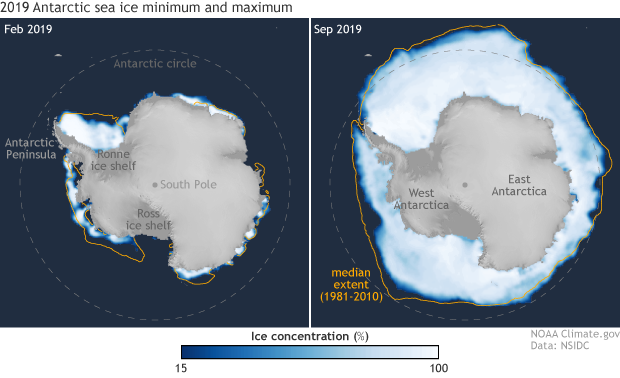
Sea ice concentration in the Southern Ocean around Antarctica during the most recent summer minimum (February 2019, left) and winter maximum (September 2019, right). The gold line shows the median ice extent (the total area that is at least 15% ice covered) from 1981–2010. Due to geography, Antarctic sea ice extents are larger than the Arctic's in winter, and smaller in summer. Maps by Climate.gov, based on data from the National Snow and Ice Data Center.
Because it forms at lower, warmer latitudes, less Antarctic sea ice survives the summer. On average, 41 percent of the Arctic Ocean’s winter ice cover remains at the summer minimum, whereas in the Southern Ocean only about 15 percent does. Because so little Antarctic ice persists throughout the summer, Antarctic ice is relatively thin, often 1 meter (about 3 feet) or less. (In the Arctic, multiyear ice that survives at least one summer is generally 3 to 4 meters thick, and even seasonal ice that formed since the previous summer can often reach about 2 meters in thickness.) So overall, average Antarctic ice thickness is much lower than Arctic sea ice.
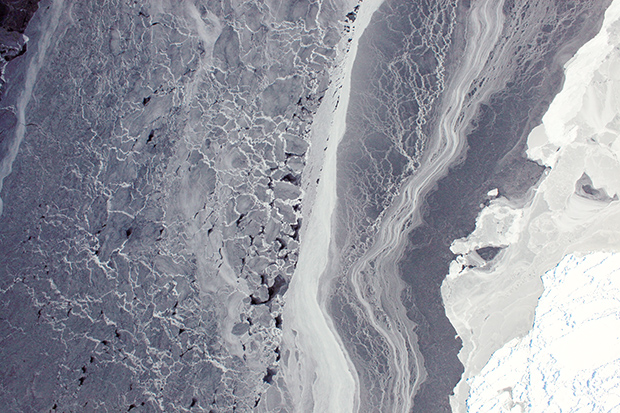
Young, thin ice floats in the Amundsen Sea on October 16, 2009. The brighter the ice, the more it has been compacted by wind and waves. Photo captured by the DMS camera on the first flight of NASA’s Operation Ice Bridge Campaign. Photo courtesy NASA Earth Observatory.
Variability and long-term change
Sea ice waxes and wanes with the seasons, but minimum and maximum extents rarely match from year to year; over years and decades, summer and winter extents vary. Compared to the Arctic, Antarctic sea ice shows less variability in summer, and more variability in winter. These changes largely result from the geographic differences mentioned above, namely Antarctic sea ice’s distance from the pole (sea ice can melt back all the way to the coast in summer) and unconstrained growth potential in winter. Weather events often drive variability, but have different effects in the Northern and Southern Hemispheres. Weather exerts a greater influence on the Arctic minimum, and the Antarctic maximum.
The sea ice satellite record dates back to October 25, 1978. Unlike the Arctic, where sea ice extent is declining in all areas in all seasons, Antarctic trends are less apparent. From 1979–2017, Antarctic-wide sea ice extent showed a slightly positive trend overall, although some regions experienced declines. Those exceptions have occurred around the Antarctic Peninsula. The region south and west of the Antarctic Peninsula has shown a persistent decline, but this downward trend is small compared to the high variability of Antarctic sea ice overall. Another region near the northern tip of the Peninsula, in the Weddell Sea, showed strong sea ice declines until 2006, but the ice in that region has rebounded in recent years.
The slightly positive long-term trend has persisted despite extreme variability since the mid-2010s. In 2013, 2014, and 2015, Antarctic sea ice yearly minimum extents (occurring in February or March) not only exceeded the 1981–2010 average, they also exceeded almost all the values in the satellite record for that time of year. In 2012, 2013, and 2014, yearly maximum extents (occurring in September) were successively the highest on record.
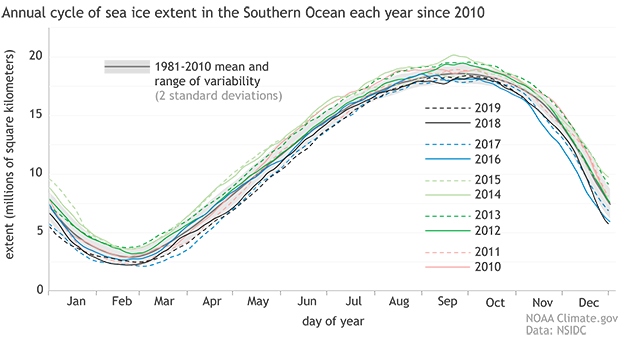
Over the past decade, Antarctic sea ice extents have shown great variability, with both record-high winter maximum extents and record-low ones. Climate.gov graph, adapted from NSIDC's Charctic.
Starting midway through 2015, Antarctic sea ice exhibited values closer to the 1981–2010 average. Then Antarctic sea ice began to fall below the long-term range of variability (encompassing 80 percent of the range of values around the 1981–2010 average). Since September 2016, Antarctic sea ice extents have fallen well below the 1981–2010 average, and even below the long-term range of variability for nearly every month. Extents for 2017 and 2018 were the lowest on record for both winter maximum and summer minimum. In 2019, both the minimum and maximum extents fell below the 1981–2010 average, but neither was a record low for that time of year.
This recent shift does not necessarily signify a change in the long-term trend. According to the National Snow and Ice Data Center’s Sea Ice Index, as of early November 2019, Antarctic sea ice showed a slight positive trend since 1979—ranging from 1.9 ± 3.7 percent per decade in March, to 0.1 ± 0.8 percent per decade in November. In all months, however, extents have been noisy, with year-to-year variability dwarfing long-term trends. (Meanwhile, the Antarctic ice sheets are losing mass.)
Impacts of change
Land-sea configurations affect sea ice extents not only by limiting where ice can form, but also by introducing their own effects. In the Arctic, landmasses surround and influence the sea ice in the Arctic Ocean. Ice and (especially) snow are highly reflective, bouncing much of the Sun’s energy back into space. As Northern Hemisphere spring and summer snow cover declines, the underlying land surface absorbs more energy and warms. Warmer conditions on land affect the nearby ocean, and more sea ice melts as a result. The melt-warmth-melt feedback cycle means that the Arctic is warming faster than the rest of the globe.
No such polar amplification effect has occurred on a large scale in the Southern Hemisphere, however. Antarctica is surrounded by ocean, not a land surface that is losing its reflective snow and ice cover in the spring and summer. It was already normal, historically, for summertime sea ice to melt back nearly to the Antarctic coastline, leaving large expanses of the Southern Ocean exposed to heating from the summer sun. By contrast, the loss of reflective snow and ice in high northern latitudes surrounding the Arctic Basin represents a profound change from what was historically normal.
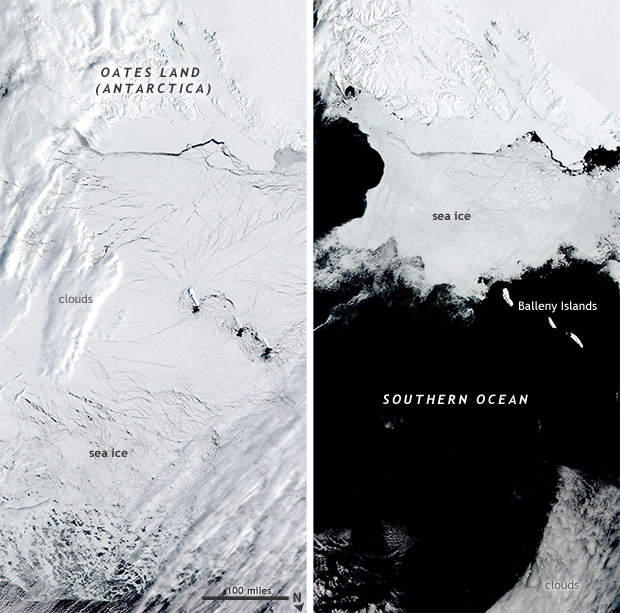
Satellite images of sea ice off the Oates Coast of Antarctica on October 7, 2018, (left) and January 12, 2019 (right). Unlike the Arctic, the Antarctic typically holds on to very little sea ice in the summer. Suomi NPP satellite images from Worldview.
Where sea ice does melt away completely in the Antarctic summer, the ice’s absence can have cascading effects. For example, sea ice retreat in the Weddell Sea along the northern tip of the Antarctic Peninsula probably contributed to Larsen Ice Shelf losses. Ice shelves—thick slabs of floating ice attached to coastlines and usually fed by glaciers—fringe the frozen continent. Intact sea ice in front of an ice shelf buffers the shelf from ocean swells. When the ice is gone, ocean waves can flex the shelf and make it more vulnerable to disintegration. Depending on how much an ice shelf disintegrates, the glacier feeding it may accelerate into the ocean. But sea ice retreat alone rarely, if ever, initiates the disintegration process; other factors such as warm ocean water and surface melt on the ice shelf are usually at work, too.
References
Antarctica is colder than the Arctic, but it’s still losing ice. (2019, March 12). Climate.gov.
Arctic Sea Ice News and Analysis, National Snow and Ice Data Center. Accessed March 27, 2019.
Charctic, National Snow and Ice Data Center. Accessed March 27, 2019.
Sea Ice Index, National Snow and Ice Data Center. Accessed April 10, 2019.
State of the Cryosphere: Ice Shelves, National Snow and Ice Data Center. Accessed March 27, 2019.
State of the Cryosphere: Sea Ice, National Snow and Ice Data Center. Accessed April 10, 2019.




No comments:
Post a Comment
Note: only a member of this blog may post a comment.